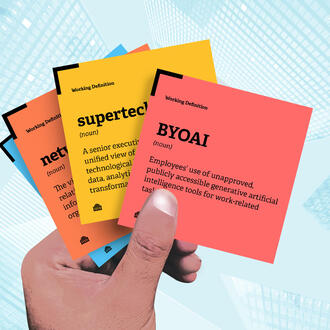Credit: Mimi Phan / Andrew Harrer via Getty Images
Procter & Gamble started out selling soaps and candles in 1837. Nearly two centuries later, it is one of the top 20 largest public companies in the world. How has it stayed so relevant?
“I would venture to guess that many of you, if asked, would view this industry and our company as an old-economy company that grows very slowly,” P&G CEO, president, and chairman of the board Jon Moeller said in late March during a talk at the Crossroads Conference hosted by the MIT Center for Transportation & Logistics. “Nothing could be further from the truth.”
In a conversation with MIT Sloan professor Charles Fine, Moeller discussed how P&G continues to prioritize customer satisfaction, navigates sustainability challenges and a rapidly changing market, and plans to stay successful for another 200 years.
Shrinking to grow
Almost 10 years ago, P&G underwent a dramatic change, reducing the size of its product portfolio from 225 brands to 65. It scaled back its presence in 22 product categories to just 10. “We focused on categories that were daily use,” Moeller said. “We returned to the core, to the things that we’re really good at.”
The result was a growth in market capitalization from about $150 billion in 2009 to about $350 billion today. At the same time, the company trimmed and simplified its organizational structure. P&G was historically divided into three areas: global brands, regions, and functions. Moeller called this “the thicket,” as its messiness made it possible for people to avoid accountability when something went wrong. It was equally difficult to know whom to credit when things went well.
Moeller asserted that a siloed corporate model divided into different functions is “an economic dinosaur.” It’s expensive, slow, “and you don’t have individuals who see the whole elephant,” he said. “They only see a piece of it, so there’s lots of room to improve the quality of decision-making.”
Finally, P&G has started integrating different parts of the supply chain under one roof as much as possible. Moeller said the company is working with Amazon to locate fulfillment centers inside P&G manufacturing facilities, for example. Having the materials it needs and the retailers it works with in the same location can reduce a degree of supply chain uncertainty.
“I’m a big believer in strategic partnerships as opposed to transactional partnerships,” Moeller said. When it comes to partners up and down the supply chain, “increasingly we’re trying to build our reality as opposed to your reality and my reality.”
Taking stock of what’s next
Moeller said that alongside organizational changes, technology is changing the way P&G conducts business. Marketing has been entirely transformed over the past dozen years. Whereas diapers or cough and cold products were once advertised on national TV, mostly reaching people who had neither babies nor colds, today’s online advertising is more precisely targeted. “Now you can receive the communication that’s helpful to you when it’s helpful to you,” he said.
New technologies are also increasing the agility of product development and production — a change accelerated by supply chain shocks and evolving consumer habits during the pandemic.
In the shadow of COVID-19, “we had to wake up every morning, put both feet on the ground, and ask, ‘OK, what’s true today?’” Moeller said. If a new formula for Tide detergent once took two months to develop, it can now be reformulated in real time depending on material costs and availability. “We’re much more fast and capable with the innovations that we bring to market,” he said.
Likewise, Moeller suspects that quality assurance processes, which currently take place only at the end of production, may soon be managed in real time — a byproduct of inexpensive sensors, photographic analysis, and the quickly scaling AI capabilities.
Such promise aside, Moeller warned against becoming “enamored by the technology.” The technology is a means to an end, he suggested, not an end in itself. “Get enamored with the pursuit of delight for consumers and customers,” he said.
Addressing the sustainability mandate
P&G must serve its consumers, customers, and employees alongside shareholders and society, Moeller said. “If we fail to do any one of these, we will fail to do all of them,” he said. Efforts around sustainability fall under service to society; the company is tackling it from three angles.
Related Articles
Most straightforward, P&G is striving to reduce its environmental footprint. The company’s greenhouse gas emissions, for instance, have gone down 57% since 2010, Moeller said, and it is pursuing a goal of zero emissions.
Second, P&G is trying to help its consumers reduce their carbon footprints. Consider clothes washing: The energy required to heat water constitutes roughly 60% of the negative environmental footprint of doing laundry. A detergent that works equally well regardless of the water temperature obviates the need to use hot water. In addition, customers save on energy costs and garments last longer — which is of particular value, given that clothes are one of the major contributors to landfills in the United States.
Moeller was very clear that P&G “can’t compromise consumer delight for environmental sustainability.” The two must be balanced; if nobody buys the product because it’s not as good as a less-sustainable alternative, “then we will accomplish nothing,” he said.
Finally, Moeller described how P&G is influencing the world of sustainability beyond its borders. He pointed to a novel recycling process developed by P&G that removes pigment and odor from recycled polypropylene.
The company doesn’t have enough demand to build a facility on its own, so it licensed the technology to a recycling company in exchange for a small fee on every ton recycled. In this way, P&G benefits financially, but so do other companies that use polypropylene, and so does the environment.
“Innovation tends to have an eye toward propriety: ‘We want something that only we can benefit from.’ We need to change that mindset or we won’t develop solutions that we’d all like to see,” Moeller said. “We’re starting to think very differently about the target for our innovators, and it’s arms open; it’s open source. If you think about it that way, then it becomes really exciting because you’re not just helping yourself — you’re helping the world.”
Read next: 2 CEOs on how to lead a socially responsible organization



